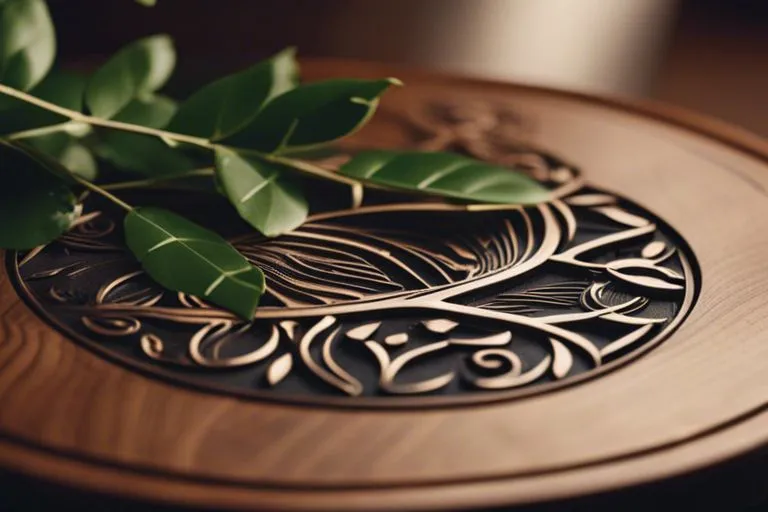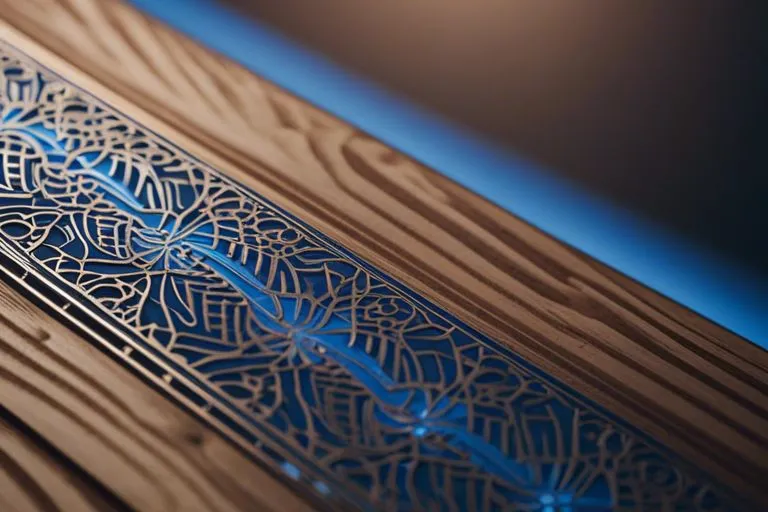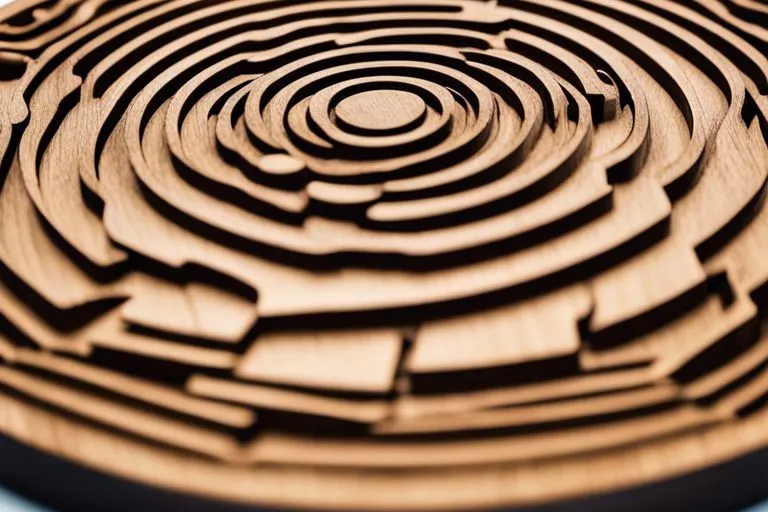Why is Wood the Best Material for Laser Engraving with Blue Lasers?

There's no denying that laser engraving has revolutionized the world of customization and personalization. Pertaining to choosing the best material for laser engraving with blue lasers, wood stands out as a top choice for several reasons. Not only does wood offer a beautiful and natural aesthetic, but it also is present in almost every household, office or shopping centre as well as outdoors. While leather is another great material for laser engraving, it is typically more expensive and less present in our everyday lives.
Wood provides a natural and elegant canvas for the laser to create detailed engravings with crisp contrast and depth. The unique characteristics of wood, such as grain patterns and natural variations, enhance the aesthetic appeal of laser engravings. Additionally, the compatibility of wood with blue lasers from Opt Lasers results in high-quality outcomes that are unsurpassed in the industry. In this article, we will examine into the unique properties of wood that make it the best material for laser engraving with blue lasers.
Characteristics of Wood for Laser Engraving
Natural Composition and Laser Interaction
Interaction with wood is a fundamental aspect of laser engraving. Wood is an organic material composed of cellulose, hemicellulose, and lignin which react very well when exposed to a engraving blue laser beams. The laser beam heats the wood, causing localized burning and vaporization (depending on optical power density and total laser power), resulting in precise and sophistacated engravings. The by-products of this interaction are all natural, and exist in nature.
Varieties of Wood and Their Engraving Qualities
One of the fascinating aspects of using wood for laser engraving is the diverse range of wood types available, each with distinct properties that affect the engraving outcome. Hardwoods such as oak and mahogany provide a rich contrast and are ideal for detailed engravings, while softer woods like pine offer a more subtle, rustic look. Different woods also vary in their density, grain pattern, and color, influencing the final engraving quality.
Qualities such as grain variation, porosity, and age impact how each wood type reacts to the laser, resulting in unique engraving effects. In addition, various species of wood react differently to the laser - for instance basswood can be engraved at twice the speed of the same-looking piece of birch veneer plywood to get the same engraving shade. Understanding the characteristics of different wood varieties can help laser engravers choose the best wood for their specific project needs and desired aesthetics.
Advantages of Blue Lasers from Opt Lasers
Next-Gen Technology That Lasts for Years
Opt Lasers prides itself in providing the most technologically advanced laser heads on the market. This means that obtaining our laser head ensures that you get the excellent results every time - not just meeting your expectations, but exceeding them. What's more our laser heads have the best longevity on the market and our clients use them for many years, saving on buying multiple replacements along the way. Opt Lasers' cutting and engraving laser heads last on average 20-200 times longer than competing products.
We also highly recommend reading our comprehensive guide to choosing the best laser engraver for wood.
Precision and Wavelength Benefits
From precision to wavelength absorption benefits, blue lasers from Opt Lasers stand out in the laser engraving industry. The shorter wavelength of blue lasers allows for finer details and sharper engravings compared to other traditional red or far-infrared lasers like CO2. Compared to CO2 lasers, blue lasers also consume 5.5 times less electricity. In particular, blue lasers laser engrave wood extremely well, as you can transfer complex photographs and paintings onto various wood surfaces effectively and with real-life-like precision.

Compatibility with Wood as an Engraving Material
Blue lasers are perfectly compatible with wood as an engraving material. Wood is a popular choice for laser engraving due to its versatility, availability, and aesthetic appeal. Blue lasers can be easily adjusted to achieve the optimal settings for engraving on different types of wood, ensuring consistent and high-quality results every time. What's more, the precision of blue lasers allows for designs and photographs to be engraved on wood without causing any damage or burning to the material. This effect is further reinforced with the addition of high-pressure air assist nozzle and a very low airflow rate, which has been attributed by blue lasers users as making the pictures even crispier and lifelike. This makes blue lasers from Opt Lasers an excellent choice for engraving wood to create custom signage, logos, and intricate artwork with ease and precision.
Techniques for Optimizing Wood Engraving
Performing the Working Distance Calibration
Typically in a laser engraving equipment, a blue laser beam is focused at some distance after the output of the laser head. This means that the beam's size gets smaller and smaller, up to a certain minimum size after which it starts to increase in size again. The point at which the beam's profile is the thinnest is called the beam waist or the focused beam spot. While you can use any laser spot size you'd liek by moving the laser head up and down, using the minimum size of the laser beam is advantageous for several reasons.
First of all, it provides you with a smaller laser spot, which means that you can laser engrave with the best precision, yielding very high-definition engravings. For XT-50 laser head, the minimum spot size is smaller than the minimum spot human eye can see. Real-life DPI is defined as the physical spot density on a real-life physical material. On the other hand, a photograph's DPI is defined as a virtual amount of spots for a given picture size. Effectively, when the picture is engraved the virtual spot density is rescaled on a large real-life material (into a real-life DPI), which is why certain high-definition photographs do not appear as high-definition once engraved. But the real-life DPI always stays the same! This means that if you use a picture that is detailed enough for a given engraving size, the real-life DPI of a laser head will always ensure that the resulting picture sharpness always matches your laser head's real-life DPI. In practice, a bare human eye can notice differences in engraving quality up to a real-life DPI of 338 (dots per inch). While the XT-50 laser head after performing the working distance calibration, will laser engrave with a real-life DPI above 550 dots per inch!
Secondly, using the beam spot at its minimum size, increases the density of laser power (laser power per laser spot area) at a given spot, also called the optical power density. For all materials, this will allow you to engrave a given total engraving area faster, although the speed increase varies from material to material. This is because the laser power can then do the work more efficiently, as the laser's energy is not transferred out as quickly for a given material's thermal conductivity and thermal capacity. Effectively, this effect is more pronounced in materials with high thermal conductivity such as for instance stainless steel.
To perform the working distance calibration, you need to engrave a set of lines, with each line being engraved at a different laser head's height above the material.Then, you look for the thinnest engraved line or the deepest engraving. Typically it is recommended to calibrate the working distance with at least 0.004" (0.1 mm) of precision. Nevertheless due to the significant payoff in engraving speed, it is not uncommon for users of XT-50 to do three consecutive working distance calibration runs. Their third and last calibration is done in 0.02-0.04 mm interations (in both directions) around the best working distance established during the the second calibration run.
Selecting the Right Wood Type
Selecting the right wood type is important for achieving the best results in laser engraving. Different wood types have varying densities and compositions, which affect how they interact with the laser beam. For example, hardwoods like maple and cherry produce crisp, detailed engravings, while softwoods like pine may result in a more rustic look. This effectively influences what end product you will obtain. Hence it's imperative to consider the desired outcome and choose a wood type that complements your design. Certain types of processed woods are manufactured with much different resins, some of which make it more diffcult to engrave or cut wood.

Tuning Laser Parameters for Best Results
In terms of optimizing wood engraving with a blue laser from Opt Lasers, tuning the laser parameters is key. Adjusting settings such as power, speed, and frequency will significantly impact the final result. Experimenting with different parameters is recommended to find the optimal combination for achieving the desired engraving shade and depth. However, the shade of engraving can a subjective matter, as different people may prefer different engraving shades. Nevertheless, by combining a few different shades of engraving often results in a product that is alluring to everyone. Finally, as mentioned before, ensuring that the working distance is calibrated properly is imperative for precise engraving.Plus, utilizing features such as grayscale engraving can further enhance the quality of your wood engravings. Grayscale engraving allows for subtle variations in engraving depth, producing more realistic images.
Certain CNC controllers of CNC machines are also of worse quality, which means they have inherently slow frequency or cannot process G-Code commands fast enough. If your CNC controller is of much worse quality, this will result in a non-linear response to laser power - under certain laser power, the material will not be marked, while above it will be dark black without the possibility of shades. While the pronounciation of this effect will vary from material to material, it can be alleviated with dithering techniques. Dithering techniques produce arrays of very small pixelated dots, with their density simulating the perceived shade of gray. Overall, this simulation of engraving shades, when performed well, qill reduce the feeling of image pixelation. Notwithstanding, it is normally better to invest in a higher quality CNC machine or just a better quality CNC controller.
Experimenting with Both Vector and Raster Engraving
It is incredibly useful to experiment with both vector and raster engraving. Vector engraving essentially means you move the laser head along predefined curves, while raster engraving engraves an image one horizontal line after another. Certain CNC controllers deal with one type much better than the other, altough the design to be engraved also plays a role. Photographs however, are almost always better performed with raster engraving.
Maintenance and Safety Considerations
Caring for Your Blue Laser Engraving Equipment
To ensure the longevity and efficiency of your blue laser engraving equipment, it is important to perform regular maintenance. Keep the laser head clean from dust and debris that could potentially damage the focusing lens. The focusing lens itself should also be cleaned with anhydrous IPA from time to time, for instance every 100 working hours. It also very useful to have a laser docking station equipped. Thank to accessory such as LaserDock, you can take off your laser head before performing non laser work such as CNC milling, and put it away in an enclosed box or cupboard. This will automatically shield it from dust generating naturally over time as well as sawdust generated durign CNC milling.
While using an air assist can increase the laser speed up to 6.5 times, it is imperative that you set up your compressor well. A compressor, apart from the flowmeter should be fitted with anti-dust filter and an oil separator which shield the laser's lens from dust and oil droplets which could damage the coating of the focusing lens, and permanently damage the focusing lens. The filter should also be exchanged from time to time, for instance every half a year - this however depends on the intensity of your laser cutting and engraving schedule and may be less often. Despite the filter, the air sourced by the compressor should also be already clean to avoid clogging the filter prematurely.
Safety Practices for Laser Engraving with Wood
Any laser engraving process involves potential hazards, and when working with wood, there are specific safety practices to keep in mind. Always wear appropriate protective gear, such as safety glasses, to shield your eyes from the specific laser beam's wavelength. It is absolutely imperative that the laser safety glasses protect against specific laser wavelength you are working with. If the OD spec for your laser wavelength is 0, then they don't work for your specific laser and the sitatuion is equivalent to as if you weren't wearing any safety glasses at all. Also, the higher the laser safety glasses' OD specification for your laser's wavelength the better. For instance the blue laser safety glasses in Opt Lasers' laser kits are OD7+ for the 440-455 nm, which means that less than 0.00001% of the laser beam passes through them. It is recommended to steer away from laser safety glasses that are commonly sold on the laser engraving market and specified as OD4+ for 405 nm and 445 nm laser wavelengths as these transmit almost 0.01% of the 445 nm of 405 nm laser beam.
Ensure proper ventilation in the workspace to prevent the buildup of potentially harmful fumes from the engraved wood. It is also crucial to have a clear understanding of both your machine's and laser kit's safety features and procedures. Most importantly, you should never leave the laser working unattended.
Summing Up
Following this comprehensive examination with additional helpful advice and tips, it is evident that wood stands out as the best material for laser engraving. Its unique characteristics, such as versatility, durability, universal presence in people's lives and the ability to produce high-contrast engravings, make it an ideal choice for a variety of laser engravings. The precision, top-notch technology, high quality and sheer power of Opt Lasers' blue lasers further enhance the achieved results when engraving on wood. In summarization, wood remains the top choice for laser engraving with blue lasers, offering unmatched results and endless possibilities for creativity and customization.
